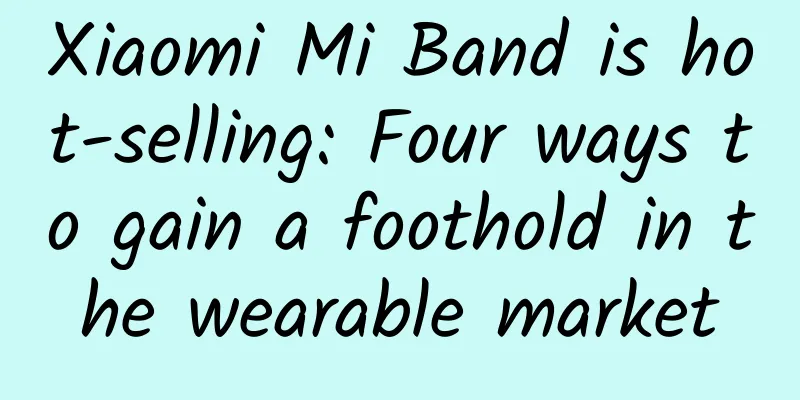Xiaomi Mi Band is hot-selling: Four ways to gain a foothold in the wearable market

|
Recently, IDC released a report on the wearable device market in the first quarter of 2015, showing that Xiaomi ranked second in the global wearable device market with 2.8 million shipments, second only to Fitbit, which ranked first. As a newcomer in the wearable device market, it is indeed surprising that it has entered the second place in the global wearable device market so quickly in terms of shipments. Considering the much attention that the wearable device manufacturer Fitbit's IPO attracted, we have to think about which type of manufacturers can or can easily find their own breakthrough and foothold in the early stage of the development of the wearable device market. According to the IDC report, the low-end market (meaning low price) is still the main driving force for the growth of wearable devices. The same IDC report said that 40% of the wearable devices are currently priced below $100, which is also an important reason why the total market share of the top five manufacturers has rapidly increased from 2/3 in the first quarter of last year to 3/4 this quarter. Specifically, Xiaomi's smart bracelet (MiBand) is priced at only $15, which should be the lowest price in the wearable device market. The second is Fitbit, which was hotly praised by the industry for its IPO some time ago. Although the industry has analyzed and praised Fitbit's success in the wearable device market because of its IPO, we calculated according to the data disclosed in its IPO prospectus (revenue of $745 million and sales of 19 million in 2014), the ASP (average price) of the smart bracelets actually sold by Fitbit is about $39, which is much lower than the price of $59-250 reported by IDC. From this point of view, the biggest driving force behind the huge gap between the top two manufacturers in global wearable device shipments in the first quarter of this year and the third-ranked manufacturer (only 700,000 shipments) is the ultra-low price. In addition to Fitbit and Xiaomi, which are driven by price, Pebble, a pure smartwatch manufacturer, has also attracted much attention because it set a record for hardware crowdfunding in the first quarter in the United States. According to statistics, Pebble sold 700,000 smartwatches in 2014 (expected to be 800,000 this year). Although the sales volume is far less than that of bracelet-type wearable devices, as a smartwatch, this sales performance is also remarkable. So why did Pebble stand out among many smartwatch manufacturers? In addition to the lower price of $199 among its smartwatch peers, we believe that it is mainly because of its accurate and pragmatic understanding and positioning of smartwatches. As its CEO Eric Migicovsky said, the key to the success of smartwatches is simplicity and practicality. Pebble is loyal to its core values and will not follow the fashion route of Apple Watch. And this simple and easy-to-use concept is implemented in Pebble smartwatches by focusing on the core functions that users use most frequently. This is very different from the idea of Apple and Google camps competing in applications. For example, at the 2015 Google I/O Developer Conference, Google said that there are currently more than 4,000 applications on its Android Wear smartwatch platform, and at Apple's second fiscal quarter 2015 earnings report conference, Apple CEO Cook also said that Apple Watch currently has more than 3,500 applications. According to the same IDC report, Samsung's global shipments of wearable devices in the first quarter were 600,000 (smart watches), ranking fourth, and it is the only Android Wear smart watch manufacturer to enter the top five. It should be pointed out that Samsung is currently producing seven smart watches. Although the shipment volume is not high in the overall wearable device market, since it only produces smart watches, Samsung's performance should be the best in terms of smart watch shipments. So why can Samsung gain a foothold in the smart watch market? First of all, Samsung has a huge shipment volume of smartphones. Although its performance has declined, its global shipment volume of smartphones in the first quarter still reached 81.1 million units (according to Gartner statistics). Given the high compatibility of Samsung smart watches with Samsung phones, even if the ratio is extremely low, it will indirectly promote the sales of its smart watches. More importantly, Samsung still uses the "sea of machines" strategy it adopted in the early days of the smartphone market in the smart watch market, which can be seen from the fact that it has 7 smart watches produced and on sale. Finally, there is Apple Watch, which is still under market verification. Since Apple Watch has just been launched, IDC did not include Apple Watch shipments in the first quarter of this year's global wearable device statistics. There are various sales statistics and forecasts for Apple Watch in the market. Therefore, it is particularly important to find a method of analysis. Due to Apple's own closed ecosystem, its Apple Watch is more compatible with the iPhone. It is said that some important functions of Apple Watch must be combined with the iPhone to be used. This determines that as the world's second largest smartphone manufacturer, the influence and shipment of its smartphones will inevitably promote the sales of its Apple Watch. More importantly, and it should be unique, the advantage that other smart watch manufacturers do not have is the "feelings" of some users for Apple products. According to a recent survey of Apple smart watch users by Wristly, although the respondents believe that Apple Watch is not a must-have, and even nearly 25% of the users are dissatisfied with Apple Watch, they will still buy it. It seems that the negative effect of over-emphasizing the practicality of a product has little impact on the sales of Apple Watch. This undoubtedly greatly dilutes the difficulty of Apple Watch competing with its rivals. In summary, we believe that in the initial stage of wearable devices, in order to find a foothold (to ensure a certain scale of shipments), price competitiveness, the ability to accurately grasp the core selling points, multiple varieties, and influence in the relevant smartphone market are all necessary to find a place in this market. So the next question is, which of the above do you have? If none of the above is true after a comprehensive comparison and analysis, it is better to enter with caution. As a winner of Toutiao's Qingyun Plan and Baijiahao's Bai+ Plan, the 2019 Baidu Digital Author of the Year, the Baijiahao's Most Popular Author in the Technology Field, the 2019 Sogou Technology and Culture Author, and the 2021 Baijiahao Quarterly Influential Creator, he has won many awards, including the 2013 Sohu Best Industry Media Person, the 2015 China New Media Entrepreneurship Competition Beijing Third Place, the 2015 Guangmang Experience Award, the 2015 China New Media Entrepreneurship Competition Finals Third Place, and the 2018 Baidu Dynamic Annual Powerful Celebrity. |
<<: Didi Kuaidi was summoned for a talk: Taxi industry reform is going in reverse
>>: Apple or Google, who will be the winner in mobile payment in the future?
Recommend
Three steps to create a social media hit
The creation of a hit product is a process of wor...
Wuwei Mindset: "Trading Sense Training Camp" 238th issue
Resource introduction of the 238th issue of "...
How do you make and receive satellite calls? Tiantong-1 satellite comes to your rescue
Tiantong satellite phone can be used as a common ...
Introduction to Wandoujia application promotion business, advertising forms, and CPD charging methods!
1. Introduction to promotion business Wandoujia i...
New media operators must survive by relying on thinking, not skills!
Many people who are just starting out or have bee...
What is Chaoshan? Fresh and lively!
This is a place your tongue knows better than you...
collect! 0-cost way to promote your app overseas!
In today's environment where overseas traffic...
Fourth-generation nuclear energy system, thorium-based molten salt experimental reactor, why can China lead the world?
Energy is an unavoidable topic in development, an...
Can you lose weight without dieting or exercising? Chinese scientists have developed a new method
#Chinese scientists discover new way to lose weig...
Basic skills of content operation: How to write product soft articles in different ways?
For content platforms that operate products , rec...
Why Apple's licensing of its iOS operating system was a bad move
In response to the declining sales of Apple iPhon...
Full set of VIP paid SEO training for the entire network with black hat SEO tutorial
Full set of VIP paid SEO training for the entire ...
Ford prepares contingency strategy for changes in purchase tax policy
Since last year, China has implemented a preferen...
See how TikTok, Mayu, PUBG, and Jump Jump opened the door to commercialization and monetization?
Where there is traffic , there are advertisements...
A brief analysis of the key points of Double 11 project operation and promotion!
When it comes to Double 11, I believe everyone is...









